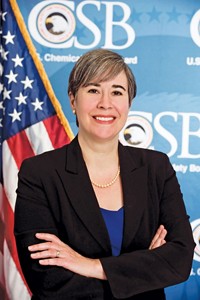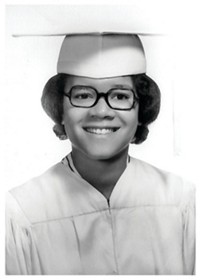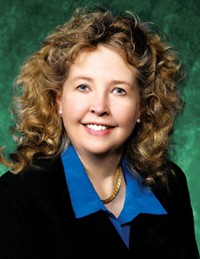Advertisement
Grab your lab coat. Let's get started
Welcome!
Welcome!
Create an account below to get 6 C&EN articles per month, receive newsletters and more - all free.
It seems this is your first time logging in online. Please enter the following information to continue.
As an ACS member you automatically get access to this site. All we need is few more details to create your reading experience.
Not you? Sign in with a different account.
Not you? Sign in with a different account.
ERROR 1
ERROR 1
ERROR 2
ERROR 2
ERROR 2
ERROR 2
ERROR 2
Password and Confirm password must match.
If you have an ACS member number, please enter it here so we can link this account to your membership. (optional)
ERROR 2
ACS values your privacy. By submitting your information, you are gaining access to C&EN and subscribing to our weekly newsletter. We use the information you provide to make your reading experience better, and we will never sell your data to third party members.
People
Movers And Shakers
C&EN profiles Cherry Murray, Energy Department’s science chief
Murray brings experience in industry, academia, and government to her new role.
by Andrea Widener
April 25, 2016
| A version of this story appeared in
Volume 94, Issue 17

When the nation needs scientific advice, it often calls on Cherry Murray.
The physicist and long time American Chemical Society member has served on at least 14 panels of the National Academy of Sciences (NAS). These panels produced scientific reports that covered topics such as the 2010 Gulf of Mexico oil well disaster and U.S. scientific competitiveness. She’s also worked on oversight boards for the Department of Energy.
Vitals
Education
B.S., physics, Massachusetts Institute of Technology, 1973; Ph.D., physics, MIT, 1978
Experience
1978–2004, Bell Laboratories
2004–2009, Lawrence Livermore National Laboratory
2009–2015, Harvard University’s School of Engineering & Applied Sciences
2015–present, Department of Energy’s Office of Science
Random facts
Murray applied to California Institute of Technology for an undergraduate degree. She was shocked when she received a postcard in response that stated the school didn’t admit women undergraduates. “It never occurred to me. This was 1969.”
At Bell Labs, Murray oversaw the fraud investigation against Bell Labs physicist Jan Hendrik Schön. After an external panel found misconduct, Schön admitted to 15 cases of fabricating data. “There may have been more, but that was enough. So I personally fired him.”
Now, Murray is influencing policy from another angle, as director of DOE’s Office of Science. That position, which she assumed in December 2015, oversees much of the agency’s basic science and energy research, as well as several national research laboratories.
“There are few people who have that kind of breadth of leadership” and also have hard-core science expertise, says chemist and entrepreneur Joseph DeSimone, who led a National Academies panel on integrating life and physical sciences of which Murray was a member. “My confidence is high that she will be able to put us into a framework as a nation to really get the most of our ecosystem of innovation.”
Murray, 64, takes on the position with the same practical, can-do spirit that has made her a favorite candidate for advisory panels. She’s also bringing experience she gained in leadership roles at some of the nation’s most notable scientific institutions: the famed industry research center Bell Laboratories, the nuclear weapons and national security research site Lawrence Livermore National Laboratory, and Harvard University’s engineering school.
She will likely hold the position at DOE for only a year—her political appointment ends when President Barack Obama’s term comes to a close. That gives her a short time to tackle important challenges in an agency that was without a Senate-confirmed leader for two years before she arrived. “I admire Cherry for taking this thing on,” says Michael Lubell, director of public affairs for the American Physical Society, who has known Murray for years.
Despite her limited horizon at DOE, Murray has come in with her eyes wide open. “I considered what I could accomplish in a year, and the answer was quite a bit,” she says.
Elsa Reichmanis, a chemistry professor at Georgia Institute of Technology who worked with Murray at Bell Labs, says Murray is levelheaded and rational, while always keeping the big picture in mind. “She has the kind of leadership skills that encourage people to try something new and to branch out and explore,” Reichmanis says.
That awareness of the big picture may have started in Murray’s childhood, which she spent traveling the world. Her father was a diplomat, so she and her siblings grew up moving every year or two, including to Japan, Pakistan, and South Korea.
Her parents were both painters who met at an artist colony in Taos, N.M. When she was growing up, Murray thought she might become a professional artist too. It wasn’t until a short stint at an Alexandria, Va., high school while her father was detailed to Saigon during the Vietnam War that Murray first got interested in science.
Murray was placed in an accelerated chemistry class. “The cool thing about the class was the labs,” Murray remembers. Most high school chemistry classes in the 1960s were strictly based on textbooks, she says. But lab exercises that had her mixing chemicals and predicting when they turned blue turned out to be a life-changing experience. That class spurred her interest in thermodynamics, which eventually led to her interest in physics. By that time her family had moved to South Korea. She ordered books from the U.S. so she could study physics on her own.
Despite that interest, Murray might not be the leader she is today if it wasn’t for a little sibling rivalry. She was deciding what scientific area to pursue in college when her brother, who is nine-and-a-half years older, told Murray she could never hack it in physics or at Massachusetts Institute of Technology, where he was then a physics graduate student. “So I applied to MIT,” she says.

Arriving at MIT in 1969, Murray jumped into the lab. She quickly developed an interest in superfluid helium and worked with physics professor Thomas J. Greytak. She spent her junior and senior year building a 3He refrigerator.
Murray stayed in Greytak’s lab for her Ph.D., where she designed an experiment examining light that scattered from molecules on surfaces in ultrahigh vacuum. She built the ultrahigh vacuum system herself, spending long hours shaping parts in the machine shop. “The thing I really liked about science was doing the experiments,” she says.
Although there were only a few women in the physics department, Murray doesn’t remember feeling out of place. “I was treated just like any other graduate student,” she says.

One of the MIT physics professors was Mildred Dresselhaus, who later led DOE’s Office of Science. Dresselhaus would not have predicted that Murray would become the scientific leader she is today. “She was interested in art and topics far abroad from what her career has been,” Dresselhaus says. But there was no doubt Murray was a standout student. “Bell Labs was the place that all the stars went to at the time, and she was a star student so she went there.”

After an internship at Bell Labs, Murray says, “I didn’t even think about going to academia because I was much more interested in doing research than in trying to get tenure.”
Paul Fleury, now a Yale University physics professor, helped recruit Murray to Bell Labs. “She was identified by her professors right from the start as someone who was bright and energetic and creative,” he says. Although that was not unique among MIT students, her personality was. “She got along very well with people. That is a little bit more unusual.”
When she first arrived as a staff scientist in 1978, Murray intended to use infrared spectroscopy to study surfaces. But she veered from that course when she heard that another scientist found an unexpectedly large signal when looking at silver electrochemical surfaces using surface-enhanced Raman scattering. So she wandered the halls to borrow equipment from her fellow scientists to study the phenomenon herself. This was an example of the collaboration that Bell Labs was famous for, Murray says.
She continued researching the light-scattering phenomena for a few more years before she transitioned to studying microscopic phase transitions in colloidal crystals.
Nine years later, she was still happily doing experiments when a Bell Labs executive approached her about moving into management. “It had never occurred to me to be a department head. I loved doing research,” she remembers. In addition, the first of her two sons was just nine months old, so it was a particularly busy time. But then she mulled over the alternatives. “Who else would be department head if I didn’t take this? I thought I would rather make the decisions.”
Being a manager at Bell Labs was a highly technical job, Murray says. It required her to understand the work that all the scientists in the department were doing and how it fit into both the lab’s mission and research writ large. She had to write one-page reports summarizing each scientist’s work. “In that job you had to be both an advocate and a critic,” Fleury explains. “She could get more information into a single page than anybody.”
Starting in 1987, Murray managed several departments, including solid-state and low-temperature physics, condensed matter physics, and semiconductor physics. In 1997 she became head of the entire Physical Research Laboratory at Bell Labs.
Murray says she “learned a tremendous amount from being a manager of all of these brilliant people and by doing science myself.”
Reichmanis says Murray’s strength as a manger comes from building consensus while keeping the big picture in mind. “She does not react negatively to differences of opinion. If anything, differences of opinion are great.”
The next few years were a time of intense transition caused by the breakup of the telecommunications business. The lab was asked to do research that was more directly related to the industry. Murray remembers it as a thrilling time because the intense competition in telecommunications spurred creative ideas, but she also remembers it as a scary time because after decades of stability no one knew where the business was headed. “I got more and more interested in business, in innovation,” she remembers. “How do you actually get products out the door—very high tech products—and link it to science?”
Then, in the early 2000s, the bottom fell out of the tech industry and Bell Labs began to break apart. Murray was overseeing layoffs twice a month and warning scientists that they should look for other jobs. “We tried to get as much external funding as we could, but it wasn’t going to be the same.”
So when Lawrence Livermore National Laboratory (LLNL) came calling in 2004, it seemed like a prime opportunity for a change. Murray was attracted to the application of science for national security. At LLNL, she oversaw the lab’s science and technology programs, including the massive—and troubled—National Ignition Facility.
Then LLNL ended up going through transition too. For the first time since LLNL’s founding in 1952, the University of California in 2006 had to enter a competition to run the lab. Murray wrote the $14 billion science and technology proposal. Even though it was eventually successful, “going through the contract competition was quite traumatic. Then we had to lay off 2,000 people. It was pretty horrible.”
After five years at LLNL, Murray was approached by Harvard University to take over as dean of its new school of engineering. She helped the school focus on its most important mission: teaching undergraduates. “It is really important for leaders of the world—many of whom are trained at Harvard as undergraduates—to understand technology, to not be afraid of it,” she says.
Murray says one of her greatest accomplishments was overseeing the creation of a computer science course that became popular among students. “The future is going to include lots of scientists and engineers. I think Cherry helped with that,” says Venkatesh Narayanamurti, who preceded Murray as dean of engineering at Harvard.
At the same time she was rising through the leadership ranks, Murray became more interested in science policy. She’s been a regular member of NAS panels—in large part because she’s a team player, according to those who have worked with her. “She’s not a bombastic, beat-you-over-the-head person. She’s very rational in her thinking and listens to people,” says Lubell from the American Physical Society.
DeSimone, who led the NAS study on interdisciplinary science, says Murray was one of the first members of the panel to respond to e-mails or finish her assigned tasks. “She has a great attention to detail and understands her role in the process,” he says.
Murray doesn’t say yes every time she’s asked to serve on a panel. “I do say yes to the ones that I think could have a national impact. And I think, by and large, they do.” She cites her work on the study into the causes of the BP oil well spill in the Gulf of Mexico. Another important study she worked on was “Rising Above the Gathering Storm,” which examined the declining support for science in the U.S.
Most recently, she was on a DOE panel examining the future of the national laboratories. This, she says, gave her the background she needed to jump quickly to the helm of the Office of Science.
But that doesn’t mean she didn’t have a lot to learn on this job. Already she’s been immersed in the details of creating federal budgets. “We are working on three budget years at once.”
And she is in the midst of deciding the future of U.S. involvement in ITER, an international magnetic fusion reactor project that is years behind schedule and far over budget. Until becoming head of the Office of Science, “I was not aware of the crisis state.”
Advertisement
One thing Murray hopes to accomplish in her short time at DOE is bringing the Office of Science’s strategic planning process to the agency’s energy-focused laboratories for the first time.
“The labs are integrators between science and energy, and that’s actually really important,” she says. The labs’ chemistry programs are a vital part of her office’s mission. Chemistry “is the science for energy,” Murray says. “It is a very big part of our portfolio.”
DeSimone is convinced that Murray is a terrific person to take on this important role. “She thinks a lot about impact and legacy, and she has a way of aligning herself with some of the most important topics,” he says. “She understands the big picture and the profound implications that energy will have for societies around the globe.”





Join the conversation
Contact the reporter
Submit a Letter to the Editor for publication
Engage with us on Twitter